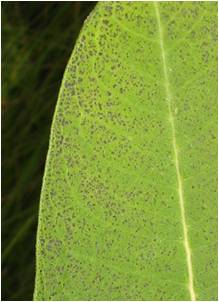Inventory & Monitoring (I&M)
Air Quality Related Values

Ozone injury to milkweed (Asclepias sp.) at Allegheny Portage NHS
Background
Air quality related values (AQRVs) are resources sensitive to air quality and include a wide array of vegetation, soils, water, fish and wildlife, and visibility. The goal of the AQRV inventory is to provide park-specific information on location, distribution, and relative sensitivity of AQRVs. And, where possible, the AQRV inventory will provide information on the types and amounts of air pollutants that cause harmful changes to AQRVs. Two series of network-specific inventory reports identify and map AQRVs in parks and networks that are sensitive to either the acidifying effects of nitrogen and sulfur deposited from air pollution or the nutrient enrichment effects of nitrogen deposition, and ranks parks and networks according to their relative risk from these pollutant effects. A third series of reports identifies plant species in parks and networks that are known to be sensitive to the phytotoxic effects of ozone and ranks parks according to relative risk from ozone injury.
Additional inventory reports and publications identify "critical loads" for AQRVs. The critical load is the amount of a specific pollutant that causes harm to an AQRV. The NPS Air Resources Division (ARD) is collaborating with federal and university scientists on a number of projects in parks to test approaches for determining critical loads that can eventually be applied more widely. These projects are prioritized according to AQRV sensitivity, and current or future threats to AQRVs. Critical loads developed for the most sensitive AQRVs will provide the basis for management goals and desired future conditions that, when attained, are expected to provide protection for AQRVs from atmospheric deposition of pollutants. AQRV inventory information can also be used by park managers and planners, and state, local, and federal air quality agencies, to ensure that activities within and outside parks do not harm AQRVs and ensure that air quality management strategies provide the highest level of protection to AQRVs.
Products
Information on AQRVs can be accessed from the Air Resources Division's Air Quality in Parks web pages and through the Integrated Resource Managment Applications site (IRMA), including lists of ozone-sensitive species. Air Quality in Parks is organized by park or network, with special emphasis on the 48 NPS Class I air quality areas that are afforded the highest protection under the Clean Air Act.
Status (May, 2012)
Reports, organized by I&M networks, are available identifying location, distribution, and relative risk of AQRVs sensitive to acidification and nutrient enrichment effects from airborne pollutants. Reports are also available for all networks identifying ozone-sensitive plant species in parks and rating relative risk to vegetation from ozone. And, an interactive web mapping application is under development to identify network and park ecosystems at risk from atmospheric deposition of mercury. Work continues to develop thresholds and critical loads for effects to vegetation, soils, lakes, and streams from pollutant deposition
More Information
- Email Ellen Porter, Inventory Coordinator - ph: (303) 969-2617
- Air Resources Information System (ARIS)
- NPS Air Resources
- Air Atlas




